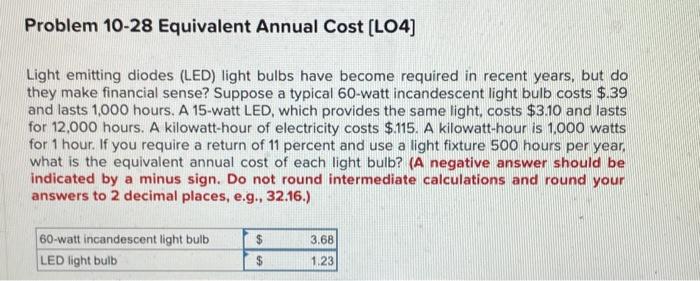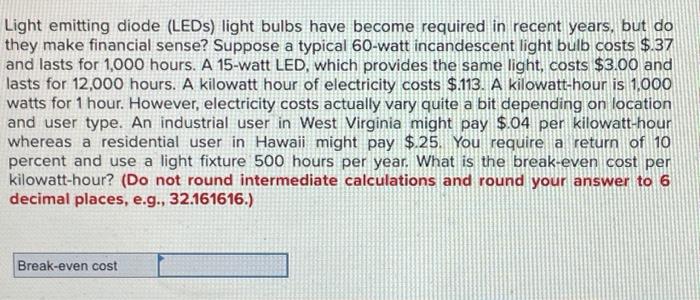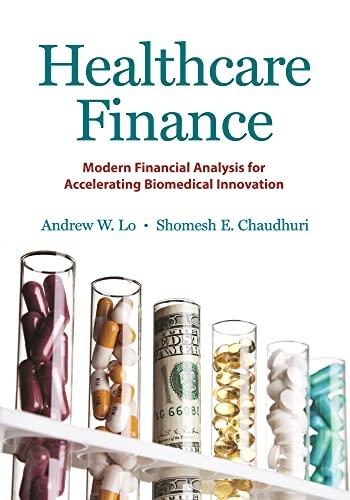Answered step by step
Verified Expert Solution
Question
1 Approved Answer
Need help answering all these problems Light emitting diodes (LED) light bulbs have become required in recent years, but do they make financial sense? Suppose
Need help answering all these problems 


Light emitting diodes (LED) light bulbs have become required in recent years, but do they make financial sense? Suppose a typical 60-watt incandescent light bulb costs $.39 and lasts 1,000 hours. A 15-watt LED, which provides the same light, costs $3.10 and lasts for 12,000 hours. A kilowatt-hour of electricity costs $.115. A kilowatt-hour is 1,000 watts for 1 hour. If you require a return of 11 percent and use a light fixture 500 hours per year. what is the equivalent annual cost of each light bulb? (A negative answer should be indicated by a minus sign. Do not round intermediate calculations and round your answers to 2 decimal places, e.g., 32.16.) Light emitting diode (LEDs) light bulbs have become required in recent years, but do they make financial sense? Suppose a typical 60-watt incandescent light bulb costs $.37 and lasts for 1,000 hours. A 15-watt LED, which provides the same light, costs $3.00 and lasts for 12,000 hours. A kilowatt hour of electricity costs $.113. A kilowatt-hour is 1,000 watts for 1 hour. However, electricity costs actually vary quite a bit depending on location and user type. An industrial user in West Virginia might pay $.04 per kilowatt-hour whereas a residential user in Hawaii might pay \$.25. You require a return of 10 percent and use a light fixture 500 hours per year. What is the break-even cost per kilowatt-hour? (Do not round intermediate calculations and round your answer to 6 decimal places, e.g., 32.161616.) Light emitting diode (LED) light bulbs have become required in recent years, but do they make financial sense? Suppose a typical 60-watt incandescent light bulb costs $.44 and lasts for 1,000 hours. A 15-watt LED, which provides the same light, costs $3.35 and lasts for 12,000 hours. A kilowatt-hour is 1,000 watts for 1 hour. Suppose you have a residence with a lot of incandescent bulbs that are used on average 500 hours a year. The average bulb will be about halfway through its life, so it will have 500 hours remaining (and you can't tell which bulbs are older or newer). If you require a return of 9 percent, at what cost per kilowatt-hour does it make sense to replace your incandescent bulbs today? (A negative answer should be indicated by a minus sign. Do not round intermediate calculations and round your answer to 6 decimal places, e.g., 32.161616.) Light emitting diodes (LED) light bulbs have become required in recent years, but do they make financial sense? Suppose a typical 60-watt incandescent light bulb costs $.39 and lasts 1,000 hours. A 15-watt LED, which provides the same light, costs $3.10 and lasts for 12,000 hours. A kilowatt-hour of electricity costs $.115. A kilowatt-hour is 1,000 watts for 1 hour. If you require a return of 11 percent and use a light fixture 500 hours per year. what is the equivalent annual cost of each light bulb? (A negative answer should be indicated by a minus sign. Do not round intermediate calculations and round your answers to 2 decimal places, e.g., 32.16.) Light emitting diode (LEDs) light bulbs have become required in recent years, but do they make financial sense? Suppose a typical 60-watt incandescent light bulb costs $.37 and lasts for 1,000 hours. A 15-watt LED, which provides the same light, costs $3.00 and lasts for 12,000 hours. A kilowatt hour of electricity costs $.113. A kilowatt-hour is 1,000 watts for 1 hour. However, electricity costs actually vary quite a bit depending on location and user type. An industrial user in West Virginia might pay $.04 per kilowatt-hour whereas a residential user in Hawaii might pay \$.25. You require a return of 10 percent and use a light fixture 500 hours per year. What is the break-even cost per kilowatt-hour? (Do not round intermediate calculations and round your answer to 6 decimal places, e.g., 32.161616.) Light emitting diode (LED) light bulbs have become required in recent years, but do they make financial sense? Suppose a typical 60-watt incandescent light bulb costs $.44 and lasts for 1,000 hours. A 15-watt LED, which provides the same light, costs $3.35 and lasts for 12,000 hours. A kilowatt-hour is 1,000 watts for 1 hour. Suppose you have a residence with a lot of incandescent bulbs that are used on average 500 hours a year. The average bulb will be about halfway through its life, so it will have 500 hours remaining (and you can't tell which bulbs are older or newer). If you require a return of 9 percent, at what cost per kilowatt-hour does it make sense to replace your incandescent bulbs today? (A negative answer should be indicated by a minus sign. Do not round intermediate calculations and round your answer to 6 decimal places, e.g., 32.161616.) 


Step by Step Solution
There are 3 Steps involved in it
Step: 1

Get Instant Access to Expert-Tailored Solutions
See step-by-step solutions with expert insights and AI powered tools for academic success
Step: 2

Step: 3

Ace Your Homework with AI
Get the answers you need in no time with our AI-driven, step-by-step assistance
Get Started


